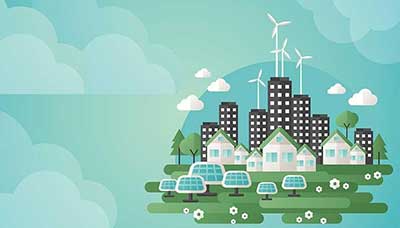Relevance: GS-3: Conservation, environmental pollution and degradation, environmental impact assessment
Key Phrases: Intergovernmental Panel on Climate Change (IPCC), ‘liability clause’, chicken-and-egg phenomenon, Indian Panchamrit, Small modular reactors (SMR), Pradhan Mantri Kisan Urja Suraksha evam Utthaan Mahabhiyan (PMKUSUM), Solar Rooftop Phase, Green Term Ahead Market (GTAM)
Why in News?
- The latest report of the Intergovernmental Panel on Climate Change (IPCC) counts India among the countries more vulnerable to climate change.
- The report underscores the need for urgent action before irreversible and unmitigable ecological damage will occur.
What are the salient observations of the editor regarding India’s Energy Bouquet?
- High Goals: India has committed to raise its non-fossil fuel capacity to 500 GW by 2030, from 152 GW now — a tall order, given the complexities in each source of non-fossil fuel energy.
- Go beyond solar: It is hard to miss the preponderance of solar in renewables installations in recent years, but to triple its non-fossil fuel power in nine years, India has to look beyond solar.
- India's Wind Dilemma:
- Wind is a good candidate, with an estimated potential of 700 GW at a hub height of 120 meters — which is easy to reach with today’s technology — but India has struggled to add even 3 GW a year (except in 2016-17, when it added 5.4 GW).
- States’ reluctance to allocate windy sites to centrally auctioned capacities and concerns over intermittency of generation.
- In all these years, India has built up 40 GW of wind capacity; it wouldn’t be realistic to expect too much from this sector within a decade.
- Offshore wind is like chicken-and-egg phenomenon for India:
- Today, offshore wind power is too expensive — around ₹8 a kWhr — essentially due to high installation costs.
- These costs will come down only with scale, but installations can be scaled up by India only if energy costs come down.
- India is lacking behind both in indigenous Research and Development and global collaboration.
What are Indian Panchamrits, to deal with the climate change challenge ?
- India will reach its non-fossil energy capacity to 500 GW by 2030.
- India will meet 50 per cent of its energy requirements from renewable energy by 2030.
- India will reduce the total projected carbon emissions by one billion tons from now onwards till 2030.
- By 2030, India will reduce the carbon intensity of its economy by less than 45 per cent.
- By the year 2070, India will achieve the target of Net Zero Emission. These panchamrits will be an unprecedented contribution of India to climate action.”
What measures suggested by the Editor for diversity in Energy Bouquet?
- Hydro energy will be developed at equivalent to its potential:
- India cannot redeem its 500 GW promise unless large hydro, nuclear and ocean energy are brought into play.
- Large hydro, whose potential, estimated at 45 GW, is thrice as much as the existing capacity, has been hampered mainly by environmental concerns and rehabilitation and resettlement (R&R) issues.
- Between 1971 and 1991, India built 1,592 large dams (according to the National Register of Large Dams) , averaging 80 a year; there is no evidence of serious impairment of ecology, or of people facing hardships.
- Nuclear Power today more reliable and resilient:
- Nuclear power capacity today stands at a dismal 6,780 MW.
- There seems good scope by further adding more than the proposed 10 PHWRs of 700MW each and four more 1,000 MW plants at Kudankulam.
- The major problem is the ‘liability clause’, which has scared away reactor suppliers.
- India must choose between righteousness and practicality; given the need for climate action, the latter appears to be the button to press.
- Concerns over radiation leaks or neutralisation of radioactive wastes are exaggerated.
- Small modular reactors (SMR) are getting global attention, though none has been built. These can be sited at places vacated by retired thermal plants. India should keep a sharp eye on this source.
- Ocean actually huge reservoir of Energy but for India seems a desert
of darkness:
- India — indeed the world — has ignored ocean energies. These are expensive, like offshore wind, but costs can be tamed with scale.
- Oceans, like large hydro and nuclear, can provide 24x7 base load energy.
Do you know what are the steps taken by the Government to promote Renewable Energy(RE) ?
- Permitting Foreign Direct Investment (FDI) up to 100 percent under the automatic route.
- Setting up of RE parks to provide land and transmission to RE developers on a plug and play basis.
- Schemes such as Pradhan Mantri Kisan Urja Suraksha evam Utthaan Mahabhiyan (PMKUSUM), Solar Rooftop Phase II.
- Green Term Ahead Market (GTAM) launched to facilitate procurement of RE power through power exchange in the country.
- Waiver of Inter State Transmission System (ISTS) charges for inter-state sale of solar and wind power for projects to be commissioned by 30th June 2025.
Way Forward:
- India has energy fuel in plenty and diversity.
- It will remain important how India will harness its energy potential.
- Carbon emissions can also be controlled through carbon capture and utilisation (or sequestration) technologies.
- India needs a mix of all sources in the right measure and proportion.
Source: The Hindu BL
Mains Question:
Q. Diversity in the 'Energy bouquet' is crucial for achieving Panchamrit Pledges. However, India's energy journey so far seems centripetal to the 'solar-wind duo' and centrifugal to the 'ocean-hydro-nuclear trio'.Examine.( 15 marks).



















